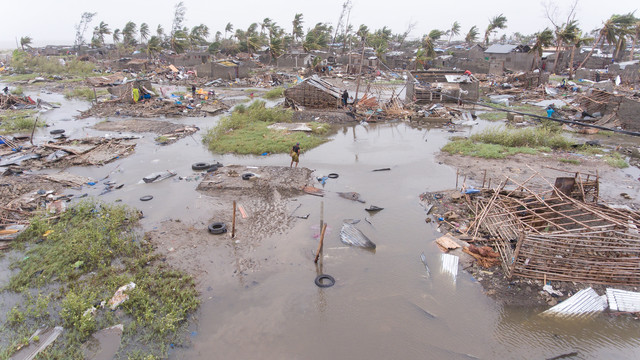Adaptation finance must reach and pass the US$40 billion target
As the world’s rich nations renew their commitment to help developing countries finance adaptation to climate change impacts, we work out the costs of basic investments in locally led adaptation and call for an urgent increase in transparent, targeted finance to build resilience among the people most vulnerable to climate change.

Ethiopia’s social protection scheme, PSNP, responds to climate-related risks such as drought, guaranteeing up to 30 days’ paid labour per household per year (Photo: UNICEF Ethiopia/Ayene, via Flickr, CC BY-NC-ND 2.0)
At the 15th UN climate change conference (COP15) in 2009, the world’s rich countries agreed to give developing countries US$100 billion a year to spend on climate change by 2020. This included a broad commitment to a ‘balance between adaptation and mitigation’, without clearly stating how much should be spent on each. But they did not meet this target, leaving people vulnerable and undermining trust between countries.
Twelve years on, at COP26 in 2021, they set a new target: to collectively double annual adaptation finance from the 2019 volume of $20 billion to $40 billion by 2025.
Although countries have made pledges behind this, they each use different methods to calculate their contributions, so their pledges are hard to understand. To rebuild trust and hold rich countries accountable for these commitments, a meaningfully transparent plan with clear division of labour is crucial.
Climate finance – what’s the issue?
Rich countries are historically responsible for climate change. And despite contributing next to nothing to the problem, low-income countries – especially least developed countries (LDCs) and Small Island Developing States (SIDS) – are suffering the impacts and bearing the costs. To address this imbalance, rich countries promised money to help developing countries adapt to climate change. But they have failed to deliver.
As droughts and floods increase in both severity and frequency, rich countries must step up and fulfil their finance commitments.
And if they prioritise the poorest countries, so they can spend this money on locally led adaptation – which allows local people to address the underlying drivers of their vulnerability and put their own solutions into action – they will have greater opportunities to survive and thrive.
How much adaptation funding is going to LDCs?
LDCs are some of the most vulnerable countries to climate change. As the world’s poorest countries, they have limited budgets and struggle to meet their immediate development needs, let alone address climate risks.
Between 2016 and 2020, rich countries gave developing countries $89.7 billion in adaptation finance. According to recent OECD figures, the 46 LDCs, which are home to over 1.1 billion people, received only $28.6 billion (32%) of this. That works out at about $8 per person.
If the rich countries meet the $40 billion target and the LDC share remains the same, they will get $12.8 billion in 2025. Factoring in population rise, this would be about $11 per person, per year. So, let’s take a look at what LDCs could do with $12.8 billion.
Adaptation finance in LDCs will rise to US$11 per person in 2025

What does this mean for people most vulnerable to climate change?
IIED works closely with partners in the global South to support the delivery of better-quality adaptation interventions, leading to a growing evidence base around locally led adaptation, including the Good Climate Finance Guide. Containing examples of several mechanisms for delivering adaptation finance, the guide considers good practice for providing support at national scale, outlining the minimum requirements for developing countries to protect development gains in poverty reduction and climate resilience.
But much more is needed – for both infrastructure investment to strengthen resilience in water and energy systems for basic services, and mitigation. Here, we take a closer look at two cost-effective options included in the guide and crunch some indicative numbers to help us understand how much money LDCs need to help their institutions and citizens adapt to the impacts of climate change.
Crunching the numbers: devolved climate finance
Making climate finance available to local governments, devolved climate finance (DCF) initiatives include local actors in adaptation planning. Enabling them to prioritise investments to build resilience to climate change puts local communities in the driving seat. And as DCF interventions produce public goods that build local resilience to drought, flooding and other risks, large numbers of people benefit.
Senegal, Kenya, Mali and Tanzania have all developed DCF approaches, at an average annual cost of just $3.21 per person. This is a minimum annual cost estimate, and schemes would benefit from having more resources available.
There is scope to scale up DCF. The World Bank recently approved a five-year $200 million DCF programme, Financing Locally Led Climate Action (FLLoCA). Based on $3.21 per person, we estimate that it would cost at least $3.8 billion a year to pay for similar schemes in every LDC from 2025 onwards. And to be effective, this would need to be a multi-year – ideally ten-year commitment – up to 2035.
Crunching the numbers: social protection schemes
From cash transfers to food aid and public works, social protection can enable more sustainable and resilient livelihood practices. And if countries can increase these payments in response to shocks, people might avoid having to sell assets to cope and distressed migration may fall.
Lower- and middle-income countries spent more than $500 billion a year on social protection schemes in 2017 and there is growing interest in using social protection to help the rural poor respond to risks and adapt to climate change.
Let’s assume the LDCs invest $3.8 billion a year to support DCF schemes. By combining climate finance with traditional development finance, they could use the remaining $9 billion make social protection more ‘climate-smart’. It is very important that any funds spent on adaptative social protection are new and additional to non-climate related finance that is already used to fund social protection.
We can use two well-established social protection schemes to illustrate this point. The Mahatma Gandhi National Rural Employment Guarantee Scheme (MGNREGS) is an Indian wage support scheme that guarantees 100 days’ paid work every year, or 150 days if there is an extreme event. Ethiopia’s Productive Safety Net Programme (PSNP) is a safety net programme that responds to climate-related risks, such as drought, guaranteeing up to 30 days’ paid labour per household each year.
In 2021, the daily cost of MGNREGS was $4.31 per person, while the PSNP cost just $1.09 per person per day across 2015-20. So, taking the average daily cost from both these schemes, we estimate that 50 extra days would cost $135 per person. If LDC governments all invest in DCF initiatives as outlined above, they could use what is left of the $12.8 billion to pay 66 million of their most vulnerable people (6% of their population) the extra 50 days’ climate-smart social protection.
But around 35.7% of people in LDCs live in extreme poverty. By 2025, this will be more than 400 million people, and extending climate-smart social protection to them all – the bare minimum required – would cost $57 billion.
$40 billion is not enough
Back in 2015, IIED estimated that LDCs would need around $93.7billion a year to fund the investments in their intended nationally determined contributions (INDCs). This calculation does not include DCF and social protection.
So, if the $40bn target is met LDCs will receive $12.8 billion in adaptation finance (assuming they get the same share as the 2016-20 average), it will be nowhere near enough to meet the basic needs for DCF and social protection for their most vulnerable citizens.
LDCs will receive US$12.8 billion of adaptation finance by 2025 if the US$40 billion target is met, which is nowhere near meeting the need

Finance providers must hit the $40 billion target to restore trust with developing countries. But this is nowhere near enough to meet LDC needs and priorities, never mind other countries’. We therefore call on rich countries to:
- Consider $40 billion the floor – a bare minimum on which to build more ambitious finance
- Offer a transparent and credible pathway to the much greater volumes of adaptation finance needed
- Tailor this support to ensure it is based on the needs and priorities of local people and communities, and
- Prioritise adaptation finance for the most vulnerable groups, especially in LDCs, SIDS and fragile states.









